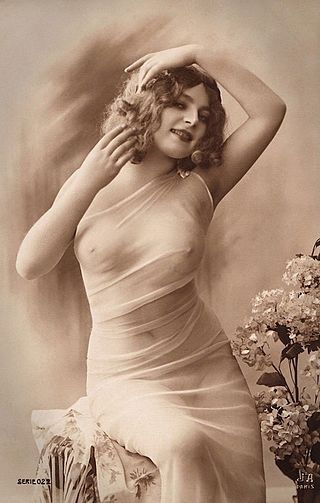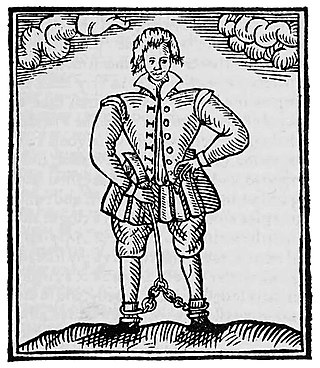Related Research Articles

Erotica is literature or art that deals substantively with subject matter that is erotic, sexually stimulating or sexually arousing. Some critics regard pornography as a type of erotica, but many consider it to be different. Erotic art may use any artistic form to depict erotic content, including painting, sculpture, drama, film or music. Erotic literature and erotic photography have become genres in their own right. Erotica also exists in a number of subgenres including gay, lesbian, women's, bondage, monster and tentacle erotica.

The Winter's Tale is a play by William Shakespeare originally published in the First Folio of 1623. Although it was grouped among the comedies, many modern editors have relabelled the play as one of Shakespeare's late romances. Some critics consider it to be one of Shakespeare's "problem plays" because the first three acts are filled with intense psychological drama, while the last two acts are comic and supply a happy ending.

A sex toy is an object or device that is primarily used to facilitate sexual pleasure, such as a dildo, artificial vagina or vibrator. Many popular sex toys are designed to resemble human genitals, and may be vibrating or non-vibrating. The term sex toy can also include BDSM apparatus and sex furniture such as sex swings; however, it is not applied to items such as birth control, pornography, or condoms. Alternative terms for sex toy include adult toy and the dated euphemism marital aid. Marital aid also has a broader meaning and is applied to drugs and herbs marketed to enhance or prolong sex.

Thomas Nashe was an Elizabethan playwright, poet, satirist and a significant pamphleteer. He is known for his novel The Unfortunate Traveller, his pamphlets including Pierce Penniless, and his numerous defences of the Church of England.
The Ur-Hamlet is a play by an unknown author, thought to be either Thomas Kyd or William Shakespeare. No copy of the play, dated by scholars to the second half of 1587, survives today. The play was staged in London, more specifically at The Theatre in Shoreditch as recalled by Elizabethan author Thomas Lodge. It includes a character named Hamlet; the only other known character from the play is a ghost who, according to Thomas Lodge in his 1596 publication Wits Misery and the Worlds Madnesse, cries, "Hamlet, revenge!"

Erotic literature comprises fictional and factual stories and accounts of eros intended to arouse similar feelings in readers. This contrasts erotica, which focuses more specifically on sexual feelings. Other common elements are satire and social criticism. Much erotic literature features erotic art, illustrating the text.

Lesbian erotica deals with depictions in the visual arts of lesbianism, which is the expression of female-on-female sexuality. Lesbianism has been a theme in erotic art since at least the time of ancient Rome, and many regard depictions of lesbianism to be erotic.

Elizabethan literature refers to bodies of work produced during the reign of Queen Elizabeth I (1558–1603), and is one of the most splendid ages of English literature. In addition to drama and the theatre, it saw a flowering of poetry, with new forms like the sonnet, the Spenserian stanza, and dramatic blank verse, as well as prose, including historical chronicles, pamphlets, and the first English novels. Major writers include William Shakespeare, Edmund Spenser, Christopher Marlowe, Richard Hooker, Ben Jonson, Philip Sidney and Thomas Kyd.

In Shakespearean scholarship, the Henriad refers to a group of William Shakespeare's history plays depicting the rise of the English kings. It is sometimes used to refer to a group of four plays, but some sources and scholars use the term to refer to eight plays. In the 19th century, Algernon Charles Swinburne used the term to refer to three plays, but that use is not current.
Whore dialogues are a literary genre of the Renaissance and the Enlightenment and a type of erotic fiction. The first example was the Ragionamenti by Pietro Aretino, followed by such works as La Retorica delle Puttane (1642) by Ferrante Pallavicino; L'École des Filles (1655), attributed to Michel Millot and Jean L'Ange and also known as The School of Venus; The Dialogues of Luisa Sigea by Nicolas Chorier—known also as A Dialogue between a Married Woman and a Maid in various editions. Such works typically concerned the sexual education of a naïve young woman by an experienced older woman and often included elements of philosophising, medical folklore, satire and anti-clericalism. The later works in this genre, such as that by Chorier, indulge in a more sophisticated type of sexual fantasy and are the precursors of the more explicit pornography which followed in Europe.
Like most playwrights of his period, William Shakespeare did not always write alone. A number of his surviving plays are collaborative, or were revised by others after their original composition, although the exact number is open to debate. Some of the following attributions, such as The Two Noble Kinsmen, have well-attested contemporary documentation; others, such as Titus Andronicus, are dependent on linguistic analysis by modern scholars; recent work on computer analysis of textual style has given reason to believe that parts of some of the plays ascribed to Shakespeare are actually by other writers.

Sonnet 145 is one of Shakespeare's sonnets. It forms part of the Dark Lady sequence of sonnets and is the only one written not in iambic pentameter, but instead tetrameter. It is also the Shakespeare sonnet which uses the fewest letters. It is written as a description of the feelings of a man who is so in love with a woman that hearing her say that "she hates" something immediately creates a fear that she is referring to him. But then when she notices how much pain she has caused her lover by saying that she may potentially hate him, she changes the way that she says it to assure him that she hates but does not hate him.

Erotic comics are adult comics which focus substantially on nudity and sexual activity, either for their own sake or as a major story element. As such they are usually not permitted to be sold to legal minors. Like other genres of comics, they can consist of single panels, short comic strips, comic books, or graphic novels/albums. Although never a mainstream genre, they have existed as a niche alongside – but usually separate from – other genres of comics.

A dildo is a sex toy, often explicitly phallic in appearance, intended for sexual penetration or other sexual activity during masturbation or with sex partners. Dildos can be made from a number of materials and shaped like an erect human penis. They are typically about the average length of an erect penis, 4–6 inches (10–15 cm), but some may be longer. A dildo's circumference is typically 4–5 inches (10–13 cm).

Sonnet 127 of Shakespeare's sonnets (1609) is the first of the Dark Lady sequence, called so because the poems make it clear that the speaker's mistress has black hair and eyes and dark skin. In this poem the speaker finds himself attracted to a woman who is not beautiful in the conventional sense, and explains it by declaring that because of cosmetics one can no longer discern between true and false beauties, so that the true beauties have been denigrated and out of favour.
Damaris Page also known as Damarose Page, was a London brothel keeper, entrepreneur and property developer, one of the most successful and famous prostitutes of her time.

Pierce Penniless his Supplication to the Divell is a tall tale, or a prose satire, written by Thomas Nashe and published in London in 1592. It was among the most popular of the Elizabethan pamphlets. It was reprinted in 1593 and 1595, and in 1594 was translated into French. It is written from the point of view of Pierce, a man who has not met with good fortune, who now bitterly complains of the world's wickedness, and addresses his complaints to the devil. At times the identity of Pierce seems to conflate with Nashe's own. But Nashe also portrays Pierce as something of an arrogant and prodigal fool. The story is told in a style that is complex, witty, fulminating, extemporaneous, digressive, anecdotal, filled with wicked descriptions, and peppered with newly minted words and Latin phrases. The satire can be mocking and bitingly sharp, and at times Nashe’s style seems to relish its own obscurity.
Charles Goodall is a minor English poet. A student of Eton College and then Merton College, Oxford, he wrote a number of romantic and erotic poems referring to male students at said colleges. In 1689, the year of his death, he put together a collection entitled Poems and Translations which contains 33 poems with male-male subject matter, eleven regarding women, and 13 to a mistress named 'Idera'. A number of the homoerotic poems have been rewritten to remove the same-sex subject matter.
The Dark Lady is a woman described in Shakespeare's sonnets, and so called because the poems make it clear that she has black wiry hair, and dark, "dun"-coloured skin. The description of the Dark Lady distinguishes itself from the Fair Youth sequence by being overtly sexual. Among these, Sonnet 151 has been characterised as "bawdy" and is used to illustrate the difference between the spiritual love for the Fair Youth and the sexual love for the Dark Lady. The distinction is commonly made in the introduction to modern editions of the sonnets. As with the Fair Youth sequence, there have been many attempts to identify her with a real historical individual. A widely held scholarly opinion, however, is that the "dark lady" is nothing more than a construct of Shakespeare's imagination and art, and any attempt to identify her with a real person is "pointless".

Algernon Charles Swinburne was an English poet, playwright, novelist and critic. He wrote several novels and collections of poetry such as Poems and Ballads, and contributed to the Eleventh Edition of the Encyclopædia Britannica.
References
- ↑ Duncan-Jones, Katherine. Ungentle Shakespeare: Scenes from His Life. The Arden Shakespeare. 2001. page 57.
- ↑ Moulton, Ian (2000). Before Pornography: Erotic Writing in Early Modern England . Oxford: Oxford UP. pp. 187. ISBN 978-0-19-513709-5.
- ↑ Nicholl, Charles. A Cup of News: The Life of Thomas Nashe. Routledge & Kegan Paul. 1984. page 90–91.
- ↑ The Project Gutenberg EBook of The Choise of Valentines, by Thomas Nash
- ↑ Nicholl, Charles. A Cup of News: The Life of Thomas Nashe. Routledge & Kegan Paul. 1984. page 294.
- ↑ Moulton, Ian (2000). Before Pornography: Erotic Writing in Early Modern England . Oxford: Oxford UP. pp. 183. ISBN 978-0-19-513709-5.
- ↑ "dildo, int. and n.1.", OED Online, 3rd edn (Oxford: Oxford University Press, 2018). Accessed 29 May 2019.
- ↑ Nash, Thomas. The Choise of Valentines, Or, the Merie Ballad of Nash His Dildo. Farmer, John, editor. Dodo Press. 2007. ISBN 978-1406530568
- ↑ Sams, Eric. The Real Shakespeare; Retrieving the Early Years, 1564-1594. Yale University Press. 1995. page 108.
- ↑ Moulton, Ian (2000). Before Pornography: Erotic Writing in Early Modern England . Oxford: Oxford UP. pp. 187. ISBN 978-0-19-513709-5.
- ↑ Moulton, Ian (2000). Before Pornography: Erotic Writing in Early Modern England . Oxford: Oxford UP. pp. 186. ISBN 978-0-19-513709-5.
- ↑ Moulton, Ian (2000). Before Pornography: Erotic Writing in Early Modern England . Oxford: Oxford UP. pp. 187–93. ISBN 978-0-19-513709-5.
- ↑ Sokolova, Boika (2000). A Companion to English Renaissance Literature and Culture. Malden, MA: Blackwell. p. 401.